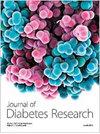Beneficial Effects of Ursodeoxycholic Acid on Metabolic Parameters and Oxidative Stress in Patients with Type 2 Diabetes Mellitus: A Randomized Double-Blind, Placebo-Controlled Clinical Study
IF 3.6
3区 医学
Q2 ENDOCRINOLOGY & METABOLISM
引用次数: 0
Abstract
Background. Oxidative stress and inflammation are closely related pathophysiological processes, both occurring in type 2 diabetes mellitus (T2DM). In addition to the standard treatment of T2DM, a potential strategy has been focused on the use of bile acids (BAs) as an additional treatment. Ursodeoxycholic acid (UDCA), as the first BA used in humans, improves glucose and lipid metabolism and attenuates oxidative stress. The aim of this study was to evaluate the potential metabolic, anti-inflammatory, and antioxidative effects of UDCA in patients with T2DM. Methods. This prospective, double-blind, placebo-controlled clinical study included 60 patients with T2DM, randomly allocated to receive UDCA or placebo. Subjects were treated with 500 mg tablets of UDCA or placebo administered three times per day (total dose of 1500 mg/day) for eight weeks. Two study visits, at the beginning (F0) and at the end (F1) of the study, included the interview, anthropometric and clinical measurements, and biochemical analyses. Results. UDCA treatment showed a significant reduction in body mass index () and in diastolic blood pressure (), compared to placebo. In addition, there was a statistically significant difference in waist circumference in the UDCA group before and after treatment (). Although no statistical significance was observed at the two-month follow-up assessment, an average decrease in glucose levels in the UDCA group was observed. After two months of the intervention period, a significant decrease in the activity of liver enzymes was noticed. Furthermore, a significant reduction in prooxidative parameters (TBARS, NO2-, H2O2) and significant elevation in antioxidative parameters such as SOD and GSH were found (). Conclusions. The eight-week UDCA administration showed beneficial effects on metabolic and oxidative stress parameters in patients with T2DM. Thus, UDCA could attenuate the progression and complications of diabetes and should be considered as an adjuvant to other diabetes treatment modalities. This trial is registered with NCT05416580.熊去氧胆酸对 2 型糖尿病患者代谢参数和氧化应激的益处:随机双盲安慰剂对照临床研究
背景。氧化应激和炎症是密切相关的病理生理过程,两者都发生在 2 型糖尿病(T2DM)中。除了对 T2DM 的标准治疗外,一种潜在的策略是使用胆汁酸(BA)作为额外的治疗手段。熊去氧胆酸(UDCA)是第一种用于人类的胆汁酸,它能改善葡萄糖和脂质代谢,减轻氧化应激。本研究旨在评估 UDCA 对 T2DM 患者的潜在代谢、抗炎和抗氧化作用。研究方法这项前瞻性、双盲、安慰剂对照临床研究包括 60 名 T2DM 患者,他们被随机分配接受 UDCA 或安慰剂治疗。受试者每天三次服用 500 毫克 UDCA 片剂或安慰剂(总剂量为每天 1500 毫克),为期八周。在研究开始(F0)和结束(F1)时进行两次访问,包括访谈、人体测量和临床测量以及生化分析。研究结果与安慰剂相比,UDCA 治疗显著降低了体重指数()和舒张压()。此外,UDCA 组的腰围在治疗前后也有显著的统计学差异()。虽然在两个月的随访评估中未观察到统计学意义,但观察到 UDCA 组的血糖水平平均有所下降。干预期两个月后,肝酶活性明显降低。此外,还发现促氧化参数(TBARS、NO2-、H2O2)明显降低,而 SOD 和 GSH 等抗氧化参数明显升高()。结论。服用八周 UDCA 对 T2DM 患者的代谢和氧化应激参数有益处。因此,UDCA 可减轻糖尿病的进展和并发症,应被视为其他糖尿病治疗方法的辅助手段。该试验已在 NCT05416580 上注册。
本文章由计算机程序翻译,如有差异,请以英文原文为准。
求助全文
约1分钟内获得全文
求助全文
来源期刊

Journal of Diabetes Research
ENDOCRINOLOGY & METABOLISM-MEDICINE, RESEARCH & EXPERIMENTAL
CiteScore
8.40
自引率
2.30%
发文量
152
审稿时长
14 weeks
期刊介绍:
Journal of Diabetes Research is a peer-reviewed, Open Access journal that publishes research articles, review articles, and clinical studies related to type 1 and type 2 diabetes. The journal welcomes submissions focusing on the epidemiology, etiology, pathogenesis, management, and prevention of diabetes, as well as associated complications, such as diabetic retinopathy, neuropathy and nephropathy.
 求助内容:
求助内容: 应助结果提醒方式:
应助结果提醒方式:


